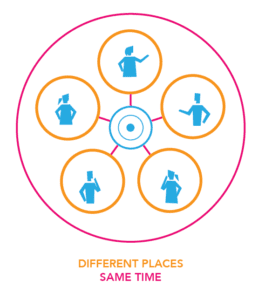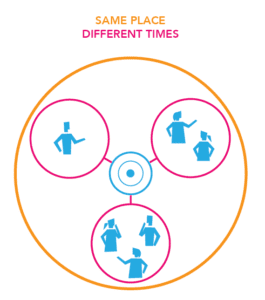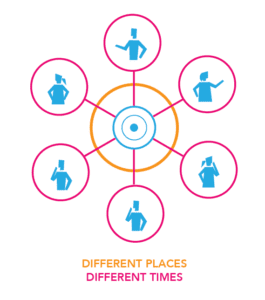Four forums for collaboration
Leading Collaboration: Part Three
Tuesday, June 18, 2019
“Coming together is a beginning. Staying together is progress. And working together is success.”
—Henry Ford
This is the third article in a series designed to help interested leaders orient themselves to collaboration. In the first article, we defined roles and five principles for guiding collaboration. In the second we discussed who to include on your collaboration team. This article examines the pros and cons of different collaboration forums.
Whether you’re taking a hands-on approach to leading collaboration or identifying the support you’ll need to build collaboration in your team, these articles are intended to give you a solid foundation.
______________
Once you’ve assembled your collaboration team and established how you’ll operate, your next challenge is creating the right forum for the team to collaborate. On the surface, this tactical challenge might appear simple. But answering the question, “how much time can I get with the team?” and, “can I get the team in the same room?” is often easier said than done.
Changes in how we work and the tools available for collaboration have forced us to rethink how we collaborate. Remote working policies, the increase of freelance or contract employees, and distributed teams (both geographically and multi-disciplinary) have made being in the same place at the same time increasingly difficult.
Fortunately, new and continually improving tools for communication, and shared, cloud-based workspaces are making non-traditional forums for collaboration more accessible and more effective. However, the degree to which people are comfortable with these tools or are allowed to access them (think enterprise firewalls and security policies) can vary significantly.
The Importance of Timing and Location
While many factors influence collaboration, the forum in which the team will collaborate is usually determined by the availability of team members and their geographic location.
Availability is defined by schedules and time zones. When the team works together at the same time, we call it synchronous collaboration. Synchronous is just a fancy term for a meeting, a workshop, or an informal team conversation that is taking place among the team members in real-time.
Asynchronous collaboration, on the other hand, is reserved for situations in which team members contribute their inputs and feedback at different times. Most often, this form of collaboration is reserved for globally distributed teams whose time zone differences prevent them from assembling at the same time. However, local team members (especially senior executives) with busy schedules can also face significant challenges in participating in real-time.
In terms of physical location, teams can either be local or remote. Local means team members are close enough in proximity to gather in a shared physical workspace. Remote means geographic distance or other circumstances prevent the team from convening in a single location.
Local collaboration may take place in a dedicated workspace, a conference room, or just a collection of desks grouped together. Occasionally, local collaboration might not involve a formal space at all. Instead, general proximity (e.g., an open workspace) allows team members to collaborate informally through daily interactions.
Remote collaboration is just the opposite. When collaborators are distributed in multiple locations, a physical shared space is not possible. In this case, collaboration might involve teleconferencing, file-sharing, video conferencing, and/or working in a virtual cloud-based collaboration space. For example, this article was written and edited collaboratively by colleagues in multiple time zones using shared Google-docs.
In the following pages, four potential collaboration forum scenarios are described in more detail, including their specific benefits and challenges. As a leader, understanding how to use different collaboration forums can help set your team up for success and enable you to adjust should circumstances change.

Four Forums for Collaboration
Local/Synchronous
Local/synchronous is what most people have in mind when they think of collaboration—a group of people working shoulder-to-shoulder in the same room focused on a specific challenge. This kind of collaboration frequently takes the form of a meeting or facilitated workshop which can take place in short, focused sessions or in multiple-day sprints.

Local/Synchronous collaboration is most often used when the collaboration team can easily gather in a common location and can commit to a specific amount of time to working together.
When kicking off a collaboration project, a local/synchronous forum is an ideal environment in which to lay the foundations for success. As the leader, this kind of forum provides a personal environment where you can set the context and establish a clear vision. It also enables immediate discussion, which accelerates your team toward clarity and alignment, especially around frameworks, agreements, and the tools the team will use.
Additionally, being together in the same space can create a shared sense of purpose and connection among participants in which remote or asynchronous approaches cannot replicate. For a facilitator or a leader, the ability to read the room can also be invaluable. You can judge reactions and follow non-verbal cues to surface and understand challenges or obstacles to be removed (one of the principles of leading collaboration). Such interpersonal insights may also help identify “champions” who can help support the ongoing collaboration.
Especially for long-term collaborations, spending time together as a team in the same room can create a strong sense of purpose and community that can pay off later when the initial thrill of the project/collaboration has faded.
Local/synchronous collaboration is not without its challenges. For example, in large face-to-face meetings, people may be reluctant to engage, defer to senior leaders, and/or be intimidated by the loudest voices in the room. In this environment, certain team members may be challenged to speak up. Even if they do, they might not feel comfortable speaking the truth (at least from their perspective). Establishing a safe space to have these essential conversations is part of your job as a leader. However challenging this might seem, the resulting clarity, alignment and trust you build among the team will be worth the effort and continue to pay off over the course of collaborating.
Learn more about the benefits and challenges of local/synchronous collaboration by downloading our cheat sheet

Remote/Synchronous
One of the greatest benefits of remote/synchronous collaboration is the ability of team members to participate regardless of their location. For global organizations or those who are adopting a more distributed employee business model, this is a critical method of collaboration.

Remote/synchronous collaboration is most often used when the collaboration team is distributed (globally or regionally) and/or comprised of employees/contractors who are not local or unavailable to be physically present.
With teleconferencing tools increasingly common in the workplace, this form of collaboration is growing in popularity and effectiveness. Yet, despite a growing number of powerful cloud-based collaboration tools like Mural, Realtime Board, and Invision to name a few, remote collaboration has not reached parity with local/synchronous collaboration. While technologies such as augmented and virtual reality will undoubtedly change this is the future, thinking of remote/synchronous collaboration as a skill-set in and of itself (rather than a less-than-perfect alternative to local/synchronous collaboration) will help collaboration teams optimize the tools currently available and explore new ways to make remote collaboration work.
This forum often requires more effort from participants (installing software, obtaining licenses, logging-in, learning to use the tools, etc.) and more active facilitation. Be aware that frustration can mount when trying to get a sense of the “entirety” of what the team is working on through a screen. Distributing goals and pre-read materials in advance and supplying “homework” helps teams come together with more background and helps participants prepare to participate in activities. Additionally, preparing a clear flow of activities and offering visuals to review can help maintain focus and encourage participation.
Of course, it’s hard to know when team members are tiring or not participating (especially if they are muted and have turned off their video feed). To combat flagging attention, keep remote/synchronous forums limited to short periods of time and ask participants to enable their video, so they avoid the temptation to multitask. Anywhere from one to three hours is a reasonable amount of time before burnout sets in. Adjust your expected outcomes accordingly.
The ease with which meetings can be recorded and shared with team members who could not attend is another benefit of using advanced remote collaboration tools. Additionally, many of these tools have a workspace in which to log and/or collect comments. If the tool you’re using doesn’t offer this, make sure someone is documenting activities and outcomes.
From time to time, collaboration team members will want to dial into a local/synchronous forum, which effectively combines the remote and local synchronous experience. If you are leading collaboration (or facilitating) this can create unique challenges. Attempts to include a remote participant can disrupt the progress of the majority of people in the room. However, input from remote participants can be invaluable. If you have the resources to help remote team members participate in local activities, (e.g., take photos of activities on the wall and immediately share or have them participate in post-up activities by asking someone to transcribe for them) take advantage of them. It’s important to remember that these people are present. Be sure to ask them for input when working with the team. Feel free to encourage in-room participants to log into the same collaboration tool with their sound muted but their video feeds active, so remote participants can see everyone in the room.
Learn more about the benefits and challenges of remote/synchronous collaboration by downloading our cheat sheet

Local/Asynchronous
What makes asynchronous collaboration significantly different is that the team isn’t always working on the same task at the same time. Of course, the absence of co-creation and direct discussion to generate clarity and alignment poses significant challenges. However, if scheduling team member time is an obstacle, this form of collaboration can still be effective.

Local/asynchronous collaboration is more common among teams who may work in close proximity but have significant demands on their time and or availability.
A common scenario for local/asynchronous collaboration involves creating a dedicated, shared workspace or war room in which team members can “drop by” to work at their convenience. In these situations, collaboration often involves asking a question of the group and allowing each collaborator to provide their responses when they can. The addition of a facilitator or dedicated team member who can be available during drop-ins to document the inputs and feedback of other collaborators will help ensure continuity of the process. Acting as a “through thread,” this person summarizes the collective input from team members and shares it with the entire collaboration team to level set on the progress made.
Ideally, collaboration teams kick-off the project synchronously, to develop a shared understanding of the vision and a clear understanding of the ground rules before beginning to work asynchronously. Once this shared understanding exists, collaborating asynchronously becomes much easier.
The greatest risk to this type of collaboration is the perception of a free-for-all collaboration in which decisions are made without discussion or alignment within the team. Increased, proactive communication in addition to agreed-upon frameworks as well as the use of a neutral host or manager to track the suggestions and highlight differences can make all the difference here.
Asynchronous collaboration can be very useful for those members of the collaboration team who prefer time to think or reflect on ideas before offering their opinion. It’s also helpful for ensuring those who might be intimidated by senior members or strong personalities to get dedicated time to voice their ideas and/or concerns.
As a leader, ensuring the team is aligned and maintaining focus can be challenging in this type of collaboration. Additional effort will be required to keep team members up-to-date on progress and ensure differences of opinion are brought to light and resolved. Assembling all of the team members for brief updates and/or discussions of specific topics can be very helpful to keep the project on track.
Learn more about the benefits and challenges of local/asynchronous collaboration by downloading our cheat sheet

Remote/Asynchronous
While synchronous collaboration promotes teamwork, remote asynchronous collaboration emphasizes individual contributions. As a result, asynchronous participation is most effective as a mechanism for gathering feedback rather than sharing and discussing issues.

Remote / Asynchronous collaboration is the least common (and least effective) forum for collaboration. It’s reserved for teams who cannot find a common space nor a common time to work together.
Improvements in cloud-based platforms and increased digital literacy, however, do enable tech-savvy participants to engage in remote, asynchronous discussions. Clearly, this requires a comfort with the technology as well as trust among the team members. Consequently, this forum may be best reserved for experienced teams who already have close working relationships.
In addition to the increased effort required of participants in a digital workspace, this forum also requires the most management by collaboration leaders. In order to keep the team moving together uniformly, leaders need to clearly map out each step, communicate requests clearly to team members, track and gather inputs, consolidate to find areas of alignment and disagreement, then report back to the group and repeat the cycle. This often leaves managers chasing team members for feedback and positions them as mediators for disagreements.
Finally, remote / asynchronous collaboration can be challenged by the inability to provide context around individual inputs. Understanding the context of team member inputs is critical to creating clarity and generating alignment and is a common source of disagreement.
Again, this forum benefits from a synchronous kick-off to the project, to develop a shared understanding of the vision and a clear understanding of the ground rules. Once this shared understanding exists, collaborating asynchronously becomes much easier.
As the collaboration manager or leader, ensuring the team is aligned and maintaining focus can be challenging in this type of forum. Additional effort is required to engage with team members and keep them up-to-date on progress. If possible, assembling all of the team members for a brief update can be very helpful to keep the project on track.
Learn more about the benefits and challenges of remote/asynchronous collaboration by downloading our cheat sheet

Use the Collaboration Forum That is Right For You
As anyone who has experienced collaboration will attest, there is no perfect forum for it. Some forums enhance the ability to co-create and engage in honest, genuine discussion. Others provide a wider range of participation and ideas or expedite the decision-making process. But in every case, your collaboration efforts will only be as successful as the team you bring to it.
As a leader, carefully consider not only the professional expertise of the team but also their comfort listening to others, sharing ideas, communicating feedback, and working through disagreement. Use your resources to support and build the foundational collaboration behaviors that will lead to success. This includes identifying a forum that plays to the team’s collective strengths. And as we’ve suggested, be prepared to change forums as needed. Be flexible. If something isn’t working, engage the team to identify the problem and experiment with possible solutions. Over time, learning how to apply the different collaboration forums will enable you to adjust quickly and efficiently as your team’s circumstances and comfort collaborating change.


